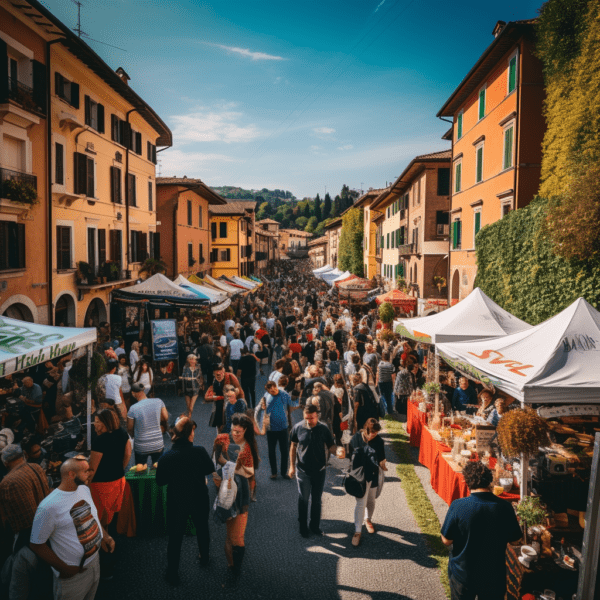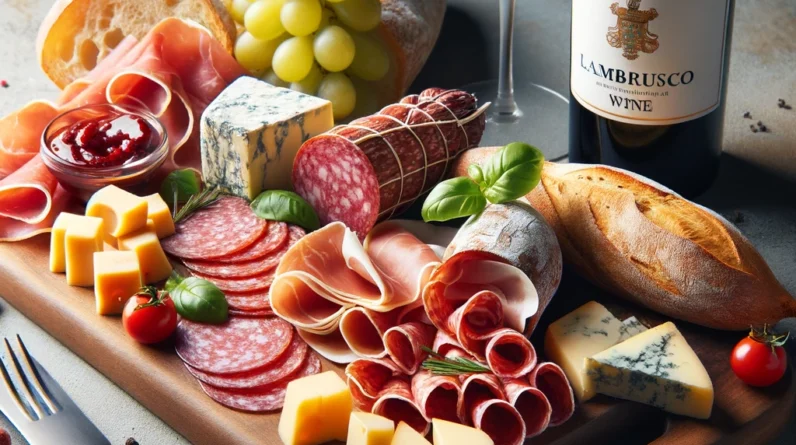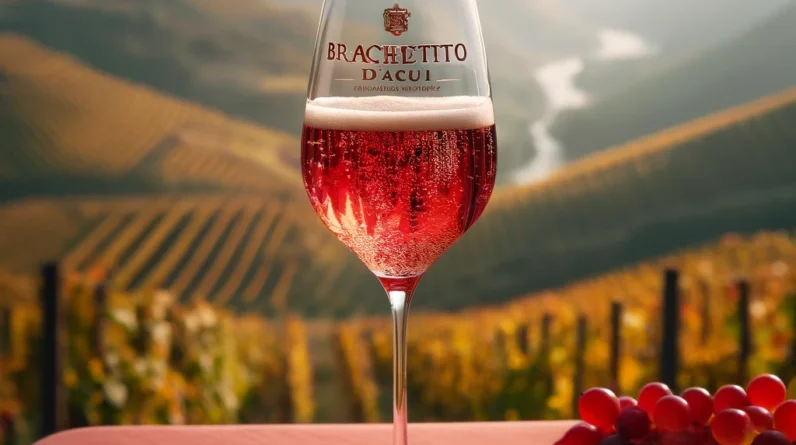
Savoring Tradition: The Exquisite Pairing of Sangiovese and Bistecca Fiorentina
Discover the culinary delight that encapsulates the essence of Tuscany: the pairing of Sangiovese wine with bistecca fiorentina.
This combination isn’t merely a meal; it’s an exploration of flavor, tradition, and the art of Italian dining.
The Sangiovese Wine: A Tuscan Gem
Sangiovese, a star in Italy’s winemaking tradition, is renowned for its role in acclaimed wines like Chianti and Brunello di Montalcino.
This grape variety thrives in the Tuscan hills, where the unique climate and soil composition impart distinct characteristics.
Sangiovese wines are known for their lovely ruby red color, medium to full body, and a flavor profile that includes tart cherry, red plum, and subtle earthy notes.
The wine’s bright acidity and robust tannins make it a versatile partner to a variety of foods, especially meats like bistecca fiorentina.

Bistecca Fiorentina: More Than Just a Steak
Bistecca fiorentina isn’t just any steak; it’s a culinary icon of Florence.
Traditionally cut from the loin of Chianina or Maremmana cattle, this steak is characterized by its large size, usually weighing between two to four pounds and standing three to four inches thick.
The preparation is a testament to Italian culinary philosophy: simplicity and quality.
Seasoned with nothing more than local Tuscan sea salt, freshly ground black pepper, and a drizzle of high-quality extra virgin olive oil, the steak is grilled over a wood fire, preferably chestnut wood,
to medium-rare perfection.
The result is a steak that’s crispy on the outside with a succulently juicy interior.
The Harmony in Pairing
The secret to why Sangiovese and bistecca fiorentina pair so beautifully lies in the balance of flavors and textures.
The high acidity and firm tannins in Sangiovese cut through the fattiness and richness of the steak, cleansing the palate between bites.
At the same time, the protein and fat in the steak mellow the wine’s tannins, making each mouthful of wine feel smoother and more nuanced.
This pairing is a classic example of the Tuscan principle of “what grows together, goes together.”
Symbolic of Tuscan Identity
This pairing goes beyond taste.
It symbolizes the Tuscan way of life, which values the connection to the land, the importance of tradition, and the pleasures of the table.
Sharing a meal of bistecca fiorentina with a bottle of Sangiovese is not just about enjoying good food and wine; it’s about participating in a ritual that has defined Tuscan culture for generations.
The Cultural Significance of Bistecca Fiorentina
The pairing of Sangiovese wine and bistecca fiorentina is deeply rooted in the history and culture of Tuscany, a region in central Italy renowned for its rich culinary traditions and winemaking
heritage.
This pairing is much more than a simple combination of food and drink; it’s a reflection of Tuscan identity, history, and lifestyle.

Historical Roots
The history of bistecca fiorentina can be traced back to the Medici era in Florence during the Renaissance.
It’s said that during the feast of San Lorenzo, large quantities of meat were grilled and distributed to the populace.
The specific cut used for bistecca fiorentina, a large T-bone steak from the Chianina cattle breed, has been central to Tuscan cuisine for centuries.
Symbol of Tuscan Cuisine
Bistecca fiorentina is more than just a dish; it’s a symbol of Tuscan cuisine, embodying the region’s culinary philosophy that emphasizes simplicity, quality ingredients, and traditional cooking
methods.
It represents a sense of pride and tradition for the Tuscans.
The Role of Sangiovese Wine in Tuscany
Winemaking Heritage
Sangiovese, the most widely planted grape variety in Italy, finds its most celebrated expressions in Tuscany.
The region’s winemaking history dates back to Etruscan times, but it was during the Middle Ages and Renaissance that it began to gain prominence.
Sangiovese-based wines like Chianti and Brunello di Montalcino have become synonymous with Tuscan winemaking.
Cultural Staple
Wine is not just a beverage in Tuscany; it’s an integral part of daily life and culture.
The Sangiovese grape, in particular, is cherished for its ability to produce wines that beautifully express the local terroir.
These wines are a source of regional pride and are celebrated in festivals and local traditions.

Culinary and Cultural Celebrations
Festivals and Events
In Tuscany, food and wine are often celebrated in local festivals and events.
The combination of Sangiovese and bistecca fiorentina is frequently featured in these celebrations, showcasing the region’s culinary heritage.
Like the Chianti Classico Wine Festival, held in the charming town of Radda in Chianti, this festival is a celebration of the famous Chianti Classico wine, which is predominantly
made from the Sangiovese grape.
Visitors can taste various Chianti Classico wines and savor traditional Tuscan dishes like bistecca fiorentina.
Or another example, Sagra del Tordo (Festival of the Thrush) that takes place in Montalcino, the home of Brunello di Montalcino (a renowned Sangiovese wine), this festival features
medieval traditions, archery contests, and a feast where Brunello pairs beautifully with various Tuscan specialties, including bistecca fiorentina.
These festivals not only showcase the celebrated wine and steak pairing but also offer a glimpse into Tuscan culture, history, and traditions.
Attending these events can provide an immersive experience in the regional lifestyle, where food and wine are central to celebrations and daily life.
Tourism and Global Recognition
This iconic pairing has also become a draw for tourists, eager to experience authentic Tuscan cuisine.
It’s a testament to how regional culinary traditions can gain international recognition and become ambassadors of a region’s cultural identity.
Finding authentic Italian dining experiences that feature the classic pairing of Sangiovese wine and bistecca fiorentina can be a highlight for anyone exploring the culinary landscape of Italy,
particularly in Tuscany.
Here are some specific tips and suggestions for those looking to immerse themselves in this quintessential Italian experience.
Researching Authentic Restaurants in Tuscany
Focus on Locally-Owned Trattorias and Osterias
To experience genuine Tuscan cuisine, seek out local trattorias and osterias.
These establishments often have a long history and are family-run, providing a more authentic and intimate dining experience.
Read Local Reviews
Utilize review sites, but pay particular attention to reviews from locals.
They are more likely to provide insights into the most authentic dining spots.
Look for Traditional Menus
Choose restaurants that specialize in Tuscan cuisine.
A good indicator is a menu that features a variety of local dishes, with bistecca fiorentina often highlighted as a specialty.
Visiting Vineyards in the Sangiovese Region
Book Vineyard Tours
Many vineyards in Tuscany offer tours that include tastings of Sangiovese wines.
Look for wineries in regions famous for Sangiovese, such as Chianti, Montalcino, and Montepulciano.
Check for Culinary Experiences
Some vineyards also offer culinary experiences, including meals where each course is paired with a specific wine.
This is an excellent way to experience the harmony between Sangiovese wines and local Tuscan cuisine.

Specific Regions to Explore
Chianti Region
Known for its picturesque landscapes and exquisite Chianti Classico wine, this region offers numerous vineyards and restaurants where you can enjoy authentic pairings.
Montalcino
Home to the renowned Brunello di Montalcino, this area boasts numerous wineries and eateries specializing in traditional Tuscan fare.
Montepulciano
Another excellent location for quality Sangiovese wines (Vino Nobile di Montepulciano) and traditional Tuscan dining.
Seasonal and Local Delicacies
Inquire About Seasonal Dishes
Many restaurants in Tuscany change their menus based on what’s in season.
Ask for any seasonal specialties that might complement the bistecca fiorentina.
Local Produce and Ingredients
Tuscany is known for its fresh produce and locally sourced ingredients.
Ensure that the restaurant you choose prides itself on using local and fresh ingredients.

Planning Your Visit
Reservations Are Key
Especially for well-known establishments, it’s advisable to book a table in advance, as they can fill up quickly, particularly during tourist season.
Consider Off-Peak Times
For a more relaxed experience, consider dining during off-peak hours or visiting vineyards on weekdays.
Engage with the Locals
Ask for Recommendations
Don’t hesitate to ask locals for their favorite spots to enjoy bistecca fiorentina and Sangiovese.
Often, the best places are those that haven’t made it onto the tourist radar yet.
Culinary Tours and Experiences
Guided Tours
Consider booking a guided culinary tour.
These tours often include visits to multiple vineyards and local eateries, providing a curated experience of the best the region has to offer.
Embracing the Tuscan Atmosphere
Take Your Time
Dining in Tuscany is not just about the food and wine; it’s about the experience.
Embrace the slower pace and enjoy the ambiance and conversation.
By following these tips, you can immerse yourself in the authentic Tuscan dining experience, savoring the legendary pairing of Sangiovese and bistecca fiorentina in its birthplace.
This is not just a meal; it’s a foray into a rich cultural and culinary heritage that defines this enchanting Italian region.

Cooking Bistecca Fiorentina: A Simple Art
Achieving the perfect bistecca fiorentina at home requires attention to detail.
Start with a high-quality T-bone or porterhouse steak, preferably from grass-fed beef.
It’s essential to bring the meat to room temperature before cooking to ensure even cooking.
Grill the steak over high, direct heat to create a charred crust while keeping the inside rare to medium-rare.
After cooking, let it rest for about half its cooking time to allow the juices to redistribute.
Finally, slice it against the grain to ensure tenderness.
Where to Buy Bistecca Fiorentina?
Buying an authentic bistecca fiorentina outside of Italy can be a bit challenging, as it traditionally comes from specific breeds of cattle native to Tuscany.
However, you can still find high-quality alternatives that will allow you to enjoy a similar experience.
Here are some options.
Specialty Butchers
Look for a high-end butcher shop or a specialty Italian grocer in your area.
These places are more likely to have cuts similar to bistecca fiorentina, which is essentially a T-bone or porterhouse steak cut very thick (at least 3-4 inches).
Online Meat Suppliers
There are numerous online retailers that specialize in high-quality meats and can provide cuts similar to bistecca fiorentina.
Look for those that offer thick-cut T-bone or porterhouse steaks.
Some might even market their steaks as “bistecca fiorentina.”
Local Farmers’ Markets
Sometimes, local farmers and ranchers at farmers’ markets offer premium cuts of meat that could be used as a substitute for the traditional bistecca fiorentina.
It’s also a great opportunity to talk directly to the producers about the best cuts they have for grilling.
Italian Delis or Markets
In some areas, Italian delis or markets import Italian products and could have connections to get a cut similar to bistecca fiorentina, or at least guide you to where you can find one.
Ask Your Local Butcher
Even if they don’t have the exact cut in stock, many butchers are willing to order specific cuts or can cut a T-bone or porterhouse steak to the necessary thickness for you.
Restaurants
While not a place to buy the steak to cook at home, some Italian or steakhouse restaurants offer bistecca fiorentina on their menu, allowing you to enjoy the dish without preparing it yourself.
Remember, the key to a good bistecca fiorentina is not just the cut, but also the quality of the meat.
Look for grass-fed, organic beef if possible, as this will provide a more authentic and flavorful experience.

Choosing the Right Sangiovese
Selecting the perfect Sangiovese to accompany your bistecca fiorentina is crucial.
For a rich, bold steak like bistecca fiorentina, opt for a Sangiovese with enough body and structure to complement the dish.
Brunello di Montalcino, with its deep flavors and ability to age gracefully, is an excellent choice.
Alternatively, a Vino Nobile di Montepulciano offers a slightly more approachable yet equally sophisticated option, with its balanced tannins and fruity, floral bouquet.
When selecting a Sangiovese wine to pair with bistecca fiorentina, you want to choose one that complements the rich, meaty flavors of the steak without overpowering it.
Here are some specific examples of excellent Sangiovese wines that would beautifully enhance the bistecca fiorentina experience.
Brunello di Montalcino
Considered one of Italy’s best and most robust Sangiovese wines, Brunello di Montalcino is an exceptional choice.
Look for renowned producers like Biondi-Santi, Poggio di Sotto, or Casanova di Neri.
These wines are known for their deep, full-bodied profile, complex flavors of dark cherry, plum, and earthy spices, and a well-structured tannic backbone.
Chianti Classico Riserva
A step up from the regular Chianti Classico, the Riserva designation means the wine has been aged longer, resulting in more depth and complexity.
Producers like Antinori, Fontodi, and Castello di Ama offer Riservas with a balance of fruitiness, acidity, and tannins that will complement the steak wonderfully.
Vino Nobile di Montepulciano
Another excellent choice, Vino Nobile di Montepulciano is known for its elegance and balance.
It’s a bit softer than Brunello, with a bouquet of red fruits, floral notes, and a hint of oak.
Wines from producers like Avignonesi and Poliziano strike a lovely balance between fruitiness and structure.
Morellino di Scansano
For a slightly lighter option that still has enough body to stand up to the steak, consider Morellino di Scansano.
It tends to be fruit-forward with a slightly spicy finish.
Fattoria Le Pupille and Moris Farms are notable producers of this wine.
Rosso di Montalcino
Sometimes referred to as Brunello’s younger sibling, Rosso di Montalcino is made from the same grape but with less aging required.
This wine is more approachable and fruit-forward, making it a great pairing for those who prefer a less intense wine.
Look for bottles from Il Poggione or Banfi for a quality choice.
Super Tuscan
While not strictly Sangiovese, many Super Tuscans use Sangiovese as a primary grape, blended with varietals like Cabernet Sauvignon and Merlot.
These wines often offer a unique and modern take on Tuscan wine, with richness and complexity that can beautifully accompany a bistecca fiorentina.
Tignanello by Antinori is a famous example.
When pairing wine with bistecca fiorentina, it’s important to consider the preparation of the steak and your personal taste preferences.
These wines, with their varying levels of body, tannin, and flavor profiles, offer a range of options to suit different palates and enhance the dining experience.
Serving the Pairing
To serve, place the sliced bistecca fiorentina on a warm platter or wooden cutting board.
Pair it with a glass of Sangiovese served at just below room temperature to enhance its flavors.
The combination of the wine’s vibrant acidity and the meat’s savory richness will offer a dining experience that is both indulgent and harmonious.

Incorporating Sangiovese and Bistecca Fiorentina into a Themed Dinner or Italian Wine Tasting Event
Organizing a themed dinner or wine tasting event centered around the classic pairing of Sangiovese and bistecca fiorentina can be an extraordinary experience.
Here’s how you can bring this quintessential Tuscan tradition to your event.
Setting the Scene
Tuscan Ambiance
Create an atmosphere reminiscent of Tuscany.
Use rustic table settings, with terracotta, wood, and simple, elegant tableware.
Incorporate elements like olive branches or sunflowers for centerpieces.
Italian Music
Enhance the ambiance with Italian music.
A playlist featuring traditional Tuscan or Italian folk music can add an authentic touch.
Wine Selection
Variety of Sangiovese Wines
Offer a range of Sangiovese-based wines, such as Chianti, Brunello di Montalcino, and Vino Nobile di Montepulciano.
This allows guests to explore different expressions of the grape.
Wine Information
Provide information about each wine, including its region, vineyard, tasting notes, and why it pairs well with bistecca fiorentina.
Consider having a sommelier or wine expert to guide the tasting.
The Star Dish – Bistecca Fiorentina
Quality Ingredients
Source high-quality T-bone or porterhouse steaks, preferably from Chianina or Maremmana cattle breeds, to ensure authenticity.
Live Cooking Demonstration
If feasible, prepare the bistecca fiorentina during the event.
A live cooking demonstration can be a focal point and offers an interactive experience.
Serving Style
Serve the steak traditionally – on a wooden cutting board, sliced, and seasoned simply with Tuscan sea salt, black pepper, and a drizzle of olive oil.
Complementary Dishes and Pairings
Antipasti
Begin with a selection of Italian antipasti like bruschetta, cured meats, and cheeses that pair well with Sangiovese.
- Pecorino Toscano: A sheep’s milk cheese from Tuscany, Pecorino Toscano has a nutty and savory flavor that complements the earthy notes of Sangiovese.
- Parmigiano-Reggiano: This hard, aged cheese with its rich, nutty flavor and crystalline texture can stand up to the boldness of Sangiovese.
- Aged Cheddar: An aged cheddar, with its sharpness and slight creaminess, can be a good match for the tannic structure of Sangiovese.
- Gouda (Especially Aged): The caramel sweetness of aged Gouda can provide a nice contrast to Sangiovese’s acidity and tannins.
- Grana Padano: Similar to Parmigiano-Reggiano, Grana Padano offers a slightly milder flavor that pairs well with the acidic nature of Sangiovese.
Side Dishes
Offer side dishes that complement the main course, such as cannellini beans in olive oil, roasted vegetables, or a simple arugula salad.
Educational Aspect
Background Information
Share the history and cultural significance of the Sangiovese and bistecca fiorentina pairing.
This can be done through printed materials, a short presentation, or informal talks during the event.
Wine and Food Pairing Principles
Explain the basics of wine and food pairing, using this classic combination as an example.
Interactive Elements
Wine Tasting Notes
Encourage guests to jot down their own tasting notes.
This not only makes the experience more interactive but also educational.
Q&A Session
Have a Q&A session with the sommelier or chef to deepen the guests’ understanding and engagement.
Souvenirs and Takeaways
Recipe Cards
Provide guests with recipe cards for bistecca fiorentina and information about the wines they tasted.
Wine Purchase Options
If possible, give guests the option to purchase the wines they enjoyed during the event.
Closing the Evening
Italian Desserts and Coffee
End the evening with classic Italian desserts like tiramisu or panna cotta, paired with espresso or a dessert wine.
By thoughtfully planning each aspect of your themed dinner or wine tasting event, you can create a memorable and immersive Tuscan culinary experience.
It’s an opportunity for guests to not only enjoy delicious food and wine but also to learn about and appreciate the rich cultural heritage behind this celebrated pairing.
The pairing of Sangiovese and bistecca fiorentina is a celebration of Tuscan culinary tradition.
It’s a journey through taste that embodies the region’s rich history, its passion for quality, and its deep-rooted love for the simplicity of flavors.
This pairing isn’t just a meal; it’s an experience, a moment to savor the true essence of Italian dining.
As you enjoy this exquisite pairing, remember that you are partaking in a centuries-old tradition that exemplifies the heart and soul of Tuscany.
Each element, from the carefully selected wine to the meticulously prepared steak, is a homage to the enduring legacy of Italian culinary artistry. Buon appetito!
FAQs:
1. What is Sangiovese?
Answer: Sangiovese is a red grape variety originating from Italy, widely known for its role in producing some of the country’s most famous wines, including Chianti, Brunello di Montalcino, and Vino
Nobile di Montepulciano.
It’s appreciated for its high acidity and tannins, along with flavors that range from savory and earthy to fruity and floral.
2. What makes bistecca fiorentina unique?
Answer: Bistecca fiorentina is a Tuscan steak made from either the Chianina or Maremmana breeds of cattle.
It’s a thick cut of T-bone steak, traditionally grilled over a wood fire and seasoned simply with salt, pepper, and olive oil. Its uniqueness lies in its preparation, quality of meat, and its place in Tuscan
culinary tradition.
3. How should Sangiovese be served with bistecca fiorentina?
Answer: Sangiovese should be served at just below room temperature to complement the rich flavors of bistecca fiorentina.
It’s best to open the bottle a few hours before serving to let the wine breathe and fully express its flavors.
4. Can other wines be paired with bistecca fiorentina?
Answer: While Sangiovese is the traditional pairing, other full-bodied red wines with good acidity and tannin structure can also complement bistecca fiorentina.
Examples include Super Tuscans, Barolo, and Cabernet Sauvignon.
5. Are there vegetarian alternatives that pair well with Sangiovese?
Answer: Yes, hearty vegetarian dishes like grilled portobello mushrooms, eggplant parmesan, or a rich tomato-based pasta can pair well with Sangiovese, complementing its acidity and flavor
profile.
6. What are the key characteristics to look for in a Sangiovese wine?
Answer: Key characteristics include a medium to full body, high acidity, and firm tannins.
Flavor-wise, Sangiovese often presents notes of cherry, plum, tomato, and earthy spices, with variations depending on the specific wine region.
7. How is bistecca fiorentina traditionally cooked?
Answer: Traditionally, bistecca fiorentina is grilled over an open flame, preferably using wood such as oak or chestnut.
It’s cooked to a rare or medium-rare level, achieving a charred exterior and a juicy, tender interior.
8. What are some recommended Tuscan side dishes to serve with this pairing?
Answer: Traditional Tuscan side dishes include cannellini beans cooked in olive oil and garlic, roasted vegetables, a simple arugula salad with lemon and olive oil, or rosemary and garlic roasted
potatoes.
9. Can this pairing be enjoyed outside of Tuscany?
Answer: Absolutely! While originating in Tuscany, Sangiovese wines and bistecca fiorentina can be enjoyed worldwide.
Many international restaurants serve authentic bistecca fiorentina, and Sangiovese wines are widely available in wine stores and online.
10. Is bistecca fiorentina suitable for all diets?
Answer: Bistecca fiorentina is a beef steak, so it’s not suitable for vegetarian, vegan, or some religious dietary restrictions.
However, its simplicity in preparation makes it adaptable for most other diets.







